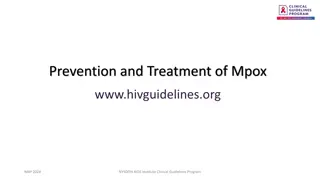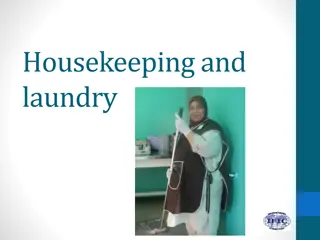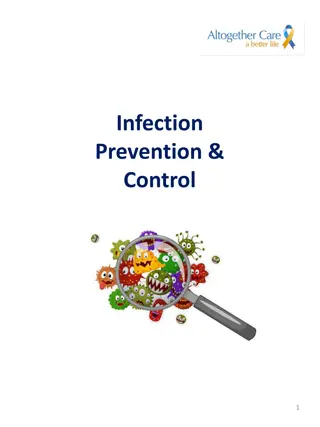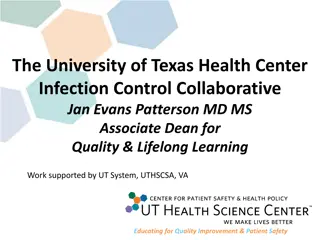Healthcare-Associated Infections Prevention Program: Best Practices
This program by the California Department of Public Health focuses on infection prevention practices during resident positioning and transferring in healthcare settings. It addresses implicit bias, hand hygiene, proper positioning importance, prevention of pressure injuries, and strategies to avoid
0 views • 38 slides
Understanding Infection Prevention & Control Measures
Infection prevention and control measures are essential in healthcare settings and beyond to prevent the transmission of infectious diseases. This article covers the basics of infection prevention, routine practices, additional precautions, and resources for further education on the topic.
4 views • 14 slides
Understanding Infection: Causes, Signs, and Nursing Management
Learn about the definition of infection, common causes, general and specific signs and symptoms, nursing assessment for foot ulcers and pressure injuries, as well as nursing interventions for infection prevention and management. Dive into the stages of infection, general and specific signs and sympt
0 views • 24 slides
Progress in Prevention and Health Inequalities - Annual Report 2023-24
The Prevention and Health Inequalities Team at BOB ICB is dedicated to enhancing prevention efforts and reducing health inequalities across their population and communities. Key achievements include setting up inpatient and maternity tobacco dependency treatment services, establishing prevention net
0 views • 14 slides
Infection Prevention in Point of Care Testing: Equipment and Hygiene Guidelines
This information focuses on infection prevention measures related to point-of-care testing (POCT), particularly concerning shared devices like lancing equipment and glucometers. It highlights the importance of evaluating equipment design, proper hand hygiene practices, and guidelines for using finge
0 views • 9 slides
Infection Control and Prevention Measures in Healthcare Settings
This project is supported by the Health Resources and Services Administration (HRSA) under the U.S. Department of Health and Human Services. It focuses on educating residents and staff in healthcare settings about infection control, prevention measures, and the use of personal protective equipment (
0 views • 19 slides
Enhancing Infection Prevention and Control in Ghana's Health Facilities
The Ghana Health Service, under the leadership of Dr. Samuel Kaba Akoriyea, has implemented initiatives to strengthen infection prevention and control (IPC) in healthcare facilities. This includes training programs for health staff, development of national technical guidelines, and establishment of
1 views • 4 slides
Effective Strategies for Infection Prevention and Control in Schools
Implementing proper infection prevention and control measures is crucial in school settings, especially during the COVID-19 pandemic. This includes promoting hand hygiene, respiratory etiquette, staying home when ill, and ensuring good ventilation. Following these guidelines can help reduce the spre
0 views • 9 slides
Update on Mental Health, Infection Prevention, Staff Vaccine, and Testing in NHS England and NHS Improvement
In the agenda for the meeting on 20th November 2020, topics included updates on mental health, staff flu vaccine and testing, infection prevention, and nosocomial infections in NHS England and NHS Improvement. The importance of preventing COVID-19 nosocomial infections was emphasized, along with fac
0 views • 10 slides
Comprehensive Guide to Infection Prevention and Control in Healthcare Facilities
This comprehensive guide outlines the objectives, structure, responsibilities, common sources of infection, and principles of infection prevention and control in healthcare facilities. The program aims to minimize the risk of healthcare-associated infections, enhance healthcare worker adherence to I
0 views • 55 slides
Feline Nematode Infection in Annual Health Visit
Millie, a 4-year-old domestic shorthair cat, was found to have Toxocara cati infection during her routine annual health visit. She was asymptomatic, and the infection was detected through a fecal exam. The treatment plan includes using an FDA-approved drug and recommending a monthly parasite prevent
2 views • 11 slides
Understanding Standardized Infection Ratio (SIR) in Healthcare-Associated Infections
The Standardized Infection Ratio (SIR) is a key measure used to monitor healthcare-associated infections (HAIs) at different levels. It compares observed HAIs with predicted values based on specific risk factors. An SIR > 1 indicates more infections than predicted, an SIR = 1 means observed equals p
0 views • 19 slides
Infection Control and Prevention Guidelines for COVID-19 in Adult Care Facilities
Review the recommendations for infection control, prevention, and isolation of COVID-19 in facilities serving adults provided by the Delaware Department of Health & Social Services. The guidelines cover core principles of infection prevention, general guidance for employees and patients, hand hygien
0 views • 54 slides
Importance of Hand Washing and Respiratory Hygiene in Infection Prevention
Understanding the importance of hand washing and covering coughs/sneezes in preventing the spread of infection is crucial. Through activities like the Toilet Paper Experiment, students can learn about microbial transmission and the significance of personal hygiene practices. Discussions around perso
0 views • 29 slides
Understanding the Epidemic of C. Difficile Infection: Insights and Implications
C. Difficile infection is a growing concern, with a significant impact on public health in the United States. High rates of infection and mortality, particularly among the elderly, highlight the urgent need for effective prevention and management strategies. The burden of C. Difficile infection exte
0 views • 59 slides
Guidelines for Prevention and Treatment of Mpox Infection
This guideline provides information on Mpox (monkeypox) including its prevention, diagnosis, and treatment. It aims to increase clinicians' awareness of the disease, offer evidence-based recommendations, and highlight key points related to Mpox infection, especially focusing on Clade II. The guideli
0 views • 18 slides
Prevention and Care of Airborne Infections in TB/HIV Settings
In this session, participants will learn the importance of infection prevention and control in TB/HIV care, levels of prevention in airborne infections, strategies to prevent TB transmission in healthcare settings, and patient management steps to prevent TB transmission. The spread of TB, risks of t
0 views • 20 slides
Understanding Infection Prevention and Control in Housekeeping and Laundry Settings
This educational material covers the crucial role of infection prevention and control in environmental services, housekeeping, and laundry settings. Key topics include cleaning practices, sources of infection, the importance of the environment, and the use of disinfectants. It emphasizes the signifi
0 views • 28 slides
Don't Eat Poop: Hygiene and Infection Prevention Guide
This comprehensive guide covers various aspects of hygiene and infection prevention, emphasizing the importance of hand hygiene, proper cleaning procedures, and protective measures to stop the spread of infectious diseases. From handwashing to surface disinfection, the content provides valuable insi
0 views • 51 slides
Infection Prevention and Control in Correctional Settings: Challenges and Strategies
This content discusses the unique challenges of infection prevention in correctional settings, including the prevalence and transmission of diseases among inmates. Strategies to prevent transmission and improve control in such environments are identified, highlighting the importance of addressing sp
0 views • 43 slides
Comprehensive Guide to Infection Prevention and Control Practices
Explore the essential practices for infection prevention, including monitoring hand hygiene compliance, educating staff and visitors, understanding how infectious diseases spread, utilizing personal protective equipment, and implementing isolation precautions for various patient conditions. Discover
0 views • 16 slides
Infection Guidelines for Data Entry Scenarios
Guidelines for entering different infection scenarios into a database, including pre-implant infections, colonization cases, and handling multiple organisms in cultures. Clear instructions on what constitutes a major infection adverse event and how to accurately document various infection situations
0 views • 18 slides
Importance of Vaccinations in Sepsis Prevention
Sepsis is a life-threatening response to infection that can lead to organ failure and death. Infection prevention through vaccinations is crucial to combat sepsis. Best practices include obtaining vaccination consent, offering education, and co-administering vaccines to older adults. Accessing vacci
1 views • 8 slides
Developing a Surgical Site Infection Bundle for Improved Patient Outcomes
Developing a comprehensive Surgical Site Infection (SSI) bundle to reduce infection rates, including interventions like preoperative chlorhexidine baths, standardized antibiotic protocols, and targeted prophylactic measures. By implementing these strategies, the aim is to lower infection rates below
0 views • 24 slides
Infection Prevention and Management in Newborns
This session focuses on the prevention, identification, and management of infections in newborns, discussing risk factors, infection prevention practices, and the use of antibiotics. Emphasizing the importance of hand hygiene, exclusive breastfeeding, and timely antibiotic use to reduce neonatal sep
0 views • 13 slides
Trends in Parasitic Copepod Infection Among Juvenile Salmonids in WVP Reservoirs Study
Study conducted by the Oregon Department of Fish and Wildlife researchers to investigate trends in parasitic copepod infection among juvenile salmonids in WVP reservoirs. The study focuses on the prevalence and intensity of infection on the gills, comparing infection levels between stream-rearing an
0 views • 12 slides
Overview of Hepatitis B Infection in Ireland: Epidemiology, Transmission, and Prevention
Hepatitis B infection is a viral liver disease transmitted through various means such as contact with infected body fluids. The virus can lead to acute or chronic infection, potentially causing severe liver complications. Vaccination programs and lifelong treatment options aim to manage and prevent
0 views • 30 slides
Understanding Athlete's Foot: Symptoms, Prevention, and Management
Athlete's foot, a common fungal infection, primarily affects the toes and can spread to the sole of the foot. Symptoms include white, itchy skin with a sogginess and odor. Severe cases with broken skin and signs of bacterial infection require referral. Prevention involves practicing good hygiene, ch
0 views • 12 slides
Evolution of Infection Prevention and Control in Healthcare
Explore the history, goals, and significance of Infection Prevention and Control (IP&C) programs in healthcare settings. Learn about the impact of IP&C initiatives on reducing healthcare-associated infections, enhancing patient safety, and optimizing healthcare delivery. Discover key milestones from
0 views • 21 slides
Comprehensive Guide to Infection Prevention and Control
Understanding the essentials of infection prevention and control is crucial in healthcare settings. This guide covers key topics such as basic principles, standard precautions, specific infections, surveillance, and prevention methods. It explores the chain of infection, factors making individuals s
0 views • 65 slides
Understanding Infection Prevention and Control for COVID-19 in Healthcare
Infection prevention and control aim to prevent harm from infections to patients and healthcare workers, based on scientific principles and patient safety. The content discusses human coronaviruses, modes of transmission, risk factors, and the role of infection prevention in healthcare settings.
0 views • 43 slides
Best Practices for Infection Prevention and Personal Protective Equipment (PPE)
Discover essential guidelines for infection prevention and PPE, including the use of personal protective equipment like uniforms and gloves, understanding the modes of transmission, respiratory etiquette, and the importance of proper cleaning practices to mitigate the spread of illnesses like COVID-
0 views • 10 slides
Assessment of HIV Prevention Programme Needs and Barriers in Ghana
Conduct a data-driven assessment of HIV prevention programme needs and barriers in Ghana based on the Ghana Road Map Baseline Survey components. Evaluate the country's preparedness in addressing HIV epidemic patterns and prevention response analysis. Identify key barriers hindering HIV prevention ef
0 views • 11 slides
Building a Business Case for Infection Prevention in Healthcare
Explore the essential reasons for a business case in infection prevention, focusing on market forces, economic viability, and the need to demonstrate value to healthcare administrators. Understand the critical role of infection control programs in healthcare facilities and the importance of cost eff
0 views • 46 slides
Guidelines for Suspecting and Managing 2019-nCoV (COVID-19) Infection
Guidelines provided by the Ministry of Public Health in Lebanon highlight the criteria for suspecting a 2019-nCoV (COVID-19) infection, including illness onset and exposure factors. It outlines symptoms to look for, such as fever and respiratory issues, as well as exposure scenarios like travel to C
0 views • 23 slides
Comprehensive Guide to Infection Prevention and Control in Health Care Settings
This curriculum guide focuses on educating healthcare professionals on the devastating effects of inadequate infection prevention and control. It covers learning objectives, knowledge requirements, performance expectations, urgency of the issue, and global responses to reduce infection rates. Topics
0 views • 17 slides
Importance of Infection Prevention and Control in Healthcare
Infection Prevention and Control is crucial to safeguarding against the spread of harmful microorganisms in healthcare settings. This comprehensive guide covers the definition of infections, types of microorganisms, modes of transmission, the immune system's role, factors predisposing to infections,
0 views • 7 slides
University of Texas Health Center Infection Control Collaborative Overview
University of Texas Health Center Infection Control Collaborative, led by Jan Evans Patterson, MD, focuses on improving patient safety through collaborative efforts. The program includes clinical and quality improvement experts working together on topics like multi-drug resistant organisms, hand hyg
0 views • 31 slides
Environmental Issues in Infection Prevention: Addressing Challenges and Best Practices
Addressing environmental issues in infection prevention is crucial for maintaining a safe healthcare facility. The challenges include room cleaning during hospitalization, disinfection post-discharge/transfer, time constraints, cost containment, ongoing education, competency assessment, and outcome
0 views • 19 slides
Guidelines for Infection Prevention & Control in Dialysis Services During COVID-19
Special healthcare services like dialysis require specific attention during the COVID-19 pandemic. This overview covers the challenges faced and provides guidelines for staff, patients, and the environment. Topics include general instructions for dialysis unit staff, monitoring of staff, and patient
0 views • 26 slides







































